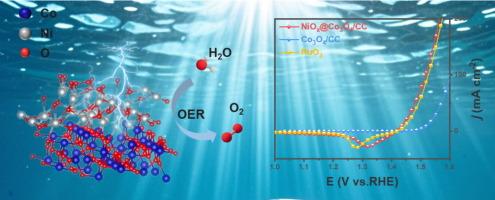Optimizing seawater electrolysis with electronically tuned Co3O4-NiOx heterostructures
IF 6.3
2区 材料科学
Q2 CHEMISTRY, PHYSICAL
引用次数: 0
Abstract
In seawater electrolysis for hydrogen production, the competition between chlorine evolution and oxygen evolution reaction (OER) at the anode limits its hydrogen yield and system stability. To address this, we optimized the anode material by modulating the surface electronic structure of the active sites of Co3O4 using atomic layer deposition (ALD) technology. By introducing the atomic layers of NiOx species, this approach results in the synthesis of a NiOx@Co3O4/Carbon cloth (CC) heterojunction, which serves as an effective oxygen evolution reaction electrocatalyst for high-performance seawater electrolysis. Adjusting the deposition cycles creates unique material interfaces that facilitate the transformation of reaction intermediate. The NiOx@Co3O4/CC heterostructure demonstrates superior catalytic performance over single-phase materials, which is attributed to its unique Ni-O-Co interface, showing low overpotentials of 204 mV in alkaline freshwater and 235 mV in seawater solutions at 10 mA cm−2, 285 mV in alkaline freshwater and 329 mV in seawater solutions at 100 mA cm−2. In addition, the incorporation of NiOx endowed the material with enhanced overall durability and corrosion resistance, reducing Cl-related species adsorption. After 300 h of chronoamperometric testing, the voltage remained stable, indicating its potential as an ideal electrocatalyst for seawater electrolysis under alkaline conditions.


电子调谐Co3O4 -NiOx异质结构优化海水电解
在海水电解制氢过程中,阳极析氯反应和析氧反应(OER)之间的竞争限制了其产氢率和系统稳定性。为了解决这一问题,我们利用原子层沉积(ALD)技术通过调制Co3O4活性位点的表面电子结构来优化阳极材料。通过引入NiOx物种的原子层,该方法合成了NiOx@Co3O4/Carbon cloth (CC)异质结,该异质结可作为高性能海水电解的有效析氧反应电催化剂。调整沉积周期可以创造独特的材料界面,促进反应中间体的转化。NiOx@Co3O4/CC异质结构表现出优于单相材料的催化性能,这是由于其独特的Ni-O-Co界面,在碱性淡水中表现出较低的过电位,在10 mA cm - 2时为204 mV,在海水溶液中为235 mV,在碱性淡水中为285 mV,在海水溶液中为329 mV,在100 mA cm - 2时。此外,NiOx的加入增强了材料的整体耐久性和耐腐蚀性,减少了cl相关物质的吸附。经过300 h的时安培测试,电压保持稳定,表明其有潜力成为碱性条件下海水电解的理想电催化剂。
本文章由计算机程序翻译,如有差异,请以英文原文为准。
求助全文
约1分钟内获得全文
求助全文
来源期刊

Applied Surface Science
工程技术-材料科学:膜
CiteScore
12.50
自引率
7.50%
发文量
3393
审稿时长
67 days
期刊介绍:
Applied Surface Science covers topics contributing to a better understanding of surfaces, interfaces, nanostructures and their applications. The journal is concerned with scientific research on the atomic and molecular level of material properties determined with specific surface analytical techniques and/or computational methods, as well as the processing of such structures.
文献相关原料
公司名称
产品信息
阿拉丁
NH4F
阿拉丁
NH4F
 求助内容:
求助内容: 应助结果提醒方式:
应助结果提醒方式:


